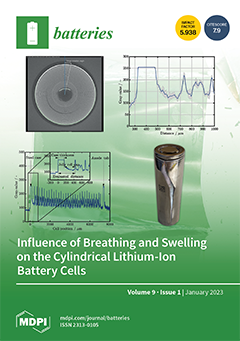Effective and inexpensive electrocatalysts are significant to improve the performance of oxygen evolution reaction. Facing the bottleneck of slow kinetics of oxygen evolution reaction, it is highly desirable to design the electrocatalyst with high activity, good conductivity, and satisfactory stability. In this work,
[...] Read more.
Effective and inexpensive electrocatalysts are significant to improve the performance of oxygen evolution reaction. Facing the bottleneck of slow kinetics of oxygen evolution reaction, it is highly desirable to design the electrocatalyst with high activity, good conductivity, and satisfactory stability. In this work, nickel foam supported hierarchical Co
9S
8–Ni
3S
2 composite hollow microspheres were derived from in situ-generative MOF precursors and the subsequent sulfurization process by a simple two-step solvothermal method. The composite microspheres were directly grown on nickel foam without any binder, and nickel foam was used as the nickel source and support material. The morphology and constitution of the series self-supported electrodes were characterized by SEM, TEM, XRD, XPS, and Raman, respectively. The unique porous architecture enriched the electrode with sufficient active surface and helped to reactants and bubble evolved during electrochemical water oxidation. Through tuning the concentration of cobalt source and ligand, the content ratio of Co
9S
8 and Ni
3S
2 can be modulated. The heterostructures not only afford active interfaces between the phases but also allow electronic transfer between Co
9S
8 and Ni
3S
2. The optimized Co
9S
8-Ni
3S
2/NF-0.6 electrode with the highest electrochemical surface area and conductivity shows the best OER performance among the series electrodes in 1 M KOH solution. The overpotential of Co
9S
8-Ni
3S
2/NF-0.6 is only 233 mV when the current density is 10 mA cm
−2, and corresponding Tafel slope is 116.75 mV dec
−1. In addition, the current density of Co
9S
8-Ni
3S
2/NF-0.6 electrocatalyst hardly decreased during the 12 h stability measurement. Our approach in this work may provide the future rational design and synthesis of satisfactory OER electrocatalysts.
Full article





